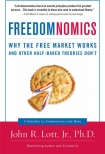Freedomnomics: Why the Free Market Works and Other Half-Baked Theories Don't John Jr. (the dot read aloud .txt) 📖

- Author: John Jr.
Book online «Freedomnomics: Why the Free Market Works and Other Half-Baked Theories Don't John Jr. (the dot read aloud .txt) 📖». Author John Jr.
27 Government expeditions seemed to make up a larger share of the lesser know accomplishments. We can speculate that perhaps government-funded explorers, like their private counterparts, were motivated partly by the desire to acquire fame. Robert Peary, a government-funded explorer who was the first man to make it to the North Pole, wrote his mother that the fame of Christopher Columbus “can be equaled only by him who shall one day stand with 360 degrees of longitude beneath his motionless feet and for whom East and West shall have vanished—the discoverer of the North Pole.” Even more directly, he told her, “Remember, mother, I must have fame.” Bruce Henderson, True North: Peary, Cook, and the Race to the Pole, (New York: W. W. Norton & Company, April 18, 2005).
28 Michael Tanner, Congressional Testimony before the Finance Committee, U.S. Senate, March 9, 1995 (http://www.cato.org/testimony/ct-ta3-9.html). Here are some examples of private charity administration and fundraising expenditures as a percent of total expenditures: Habitat for Humanity, Washington D.C.—13.8%; The Salvation Army - 16.8%; YMCA of Metropolitan Washington - 19.4%; and American Red Cross of the National Capital Area - 11.6%. Source: charitablechoices.com, Charity Descriptions, All Charities A to Z (http://www.charitablechoices.org/categories/all.asp).
29 Kelly Bedard and William Brown, “The Allocation of Public School Expenditures,” Claremont Colleges Working Paper, August, 2000, 19 (http://econ.claremontmckenna.edu/papers/2000-16.pdf).
30 The relative costs of private schools assumes that religious teachers in parochial schools are paid at the same rate as lay teachers. For further discussion, see John R. Lott, Jr., “Why is Education Publicly Provided?: A Critical Survey,” Cato Journal, Fall, 1987: 476-77.
31 Jay Hancock, “Traded Funds May be Trend T. Rowe Price Can’t Let Pass,” Baltimore Sun, September 17, 2006, D1. Congressman Michael Oxley, “Mutual Fund Industry Practices and their Effect on Individual Investors,” hearing before the Subcommittee on Capital Markets, Insurance, and Government Sponsored Enterprises Committee on Financial Services, March 12, 2003 (http://commdocs.house.gov/committees/bank/hba87798.000/hba87798_0.HTM).
32 71 percent of Americans understood that a “well-diversified portfolio will experience less volatility.” American Century Investments, On Plan I.Q. Quiz, KANSAS CITY, Mo., April 7, 2005 (http://www.americancentury.com/welcome/news_release2_2005.jsp?press_release=20050407a).
33 Robert Hansen and John Lott, “Externalities and Corporate Objectives in a World with Diversified Shareholders/Consumers,” Journal of Financial and Quantitative Analysis, (March 1996).
34 Ibid.
35 Ibid.
36 Ibid.
37 For a discussion of the role of a private predator acquiring the assets of firms that were driven out of business see John McGee, “Pedatory Price Cutting: The Standard Oil (NJ) Case,” Journal of Law and Economics, 1958-69. He also provides strong evidence that even if such actions were in fact behind Standard Oil’s acquisitions, it could not have been a successful strategy.
38 This discussion is connected to questions on the general growth of government. Related studies include Bennett and Johnson’s survey of the theories explaining why government has grown over time. I co-authored two other analyses of the problem. Lott and Fremling describe the growth of government based upon the costs of voters evaluating the long term versus short term effects of government regulation, while Kenny and Lott interpret the growth of government as a result of women’s emancipation. See John R. Lott, Jr. and Gertrud Fremling, “Time Dependent Information Costs, Price Controls, and Successive Government Intervention,” Journal of Law, Economics, and Organization, vol. 5, no. 2, Fall 1989: 293-306, and John R. Lott, Jr. and Larry Kenny, “Did Women’s Suffrage Change the Size and Scope of Government?,” Journal of Political Economy, vol. 107, no. 6, part 1, December 1999: 1163-1198. Also see James Bennett and Manuel Johnson, The Political Economy of Federal Government Growth: 1959-1978, (College Station, Texas: Texas A&M University Press, 1980).
39 Russell Hotten, “Paris Goes to War for Bigger Slice of Airbus,” Daily Telegraph (UK), November 25, 2006.
40 Michael Harrison, “Airbus may end up grounded if superjumbo fails to take off,” New Zealand Herald, November 23, 2006.
41 Hauser, Rolland K., The Interface Between Federal and Commercial Weather Services for Agricultural Industries—A Question of Policy, report prepared for the United States Department of Commerce, National Oceanic and Atmospheric Administration, Office of the Administrator, Washington, D.C. (November, 1985), 23. Jerome Ellig provides a list of other similar cases in Government and the Weather: The Privatization Option. Federal Privatization Project Issue Paper #109, Santa Monica, California: Reason Foundation (August, 1989a).
42 Jerome Ellig, “For Better Weather, Privatize,” Wall Street Journal, vol. 71 (December 4, 1989b): A16. Hauser concludes that, “Current federal agweather policy, either advertently or inadvertently, has the effect of deterring investment by private meteorology in agricultural weather services.” Hauser, ibid.
43 Michael Stone, Executive Director of UCLA’s, Marketing & Communication Services, noted that for 2004-05, UCLA spent $3.35 billion, of which around $800 million was for research expenditures and $1.13 billion was for the medical school. Even excluding research spending, with over 37,000 students, that comes to almost $40,000 per student. In-state tuition in 2006-07 was only $6,522. See http://www.admissions.ucla.edu/prospect/budget.htm. and Office of the President, University of California, 2006-07 Budget for Current Operations, University of California, November 2005. The average tuition at public universities is $5,836 according to the College Board. See Jonathan Glater and Alan Finder, “In Twist on Tuition Game, Popularity Rises With Price,” New York Times, December 12, 2006.
44 In contrast, an elite private school like Swarthmore College spends slightly more per student ($73,690) but charges much higher tuition ($33,232). The public school tuition is only 20 percent of the private school’s, but the per pupil costs of the public school are 57 percent of the private school’s. Glater and Finder, “In Twist on Tuition Game.” See also Melissa Bertosh, “2006-07 Budget Calls for Tuition Hike,” The Phoenix (Swarthmore College), March 16, 2006 (http://phoenix.swarthmore.edu/2006-03-16/news/15931), and Jeanne Sahadi, “College Costs Spike Again,” CNN/Money, October 19, 2004 (http://money.cnn.com/2004/10/18/pf/college/college_costs/index.htm?postversion=2004101910) for a breakdown of public versus private university tuitions by region of the U.S. Private school tuitions are 3.3 to 4.2





Comments (0)